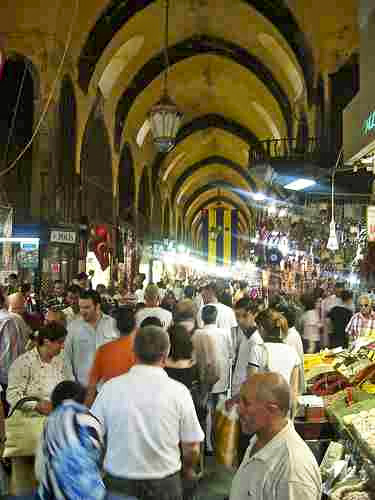Redolent of perfumes and seasoning from around the globe, Istanbul’s Spice Bazaar beckons and enchants anyone with the slightest interest in gastronomy. Designed from the start as a food emporium, the market the Turks call the Misir Carsisi, or the “Egyptian Bazaar,” after the nationality of its first tenants, is an imposing L-shaped structure gracing the southern shore of the Golden Horn.
The market’s courses of stone and pink brick arose in the 17th century as apart of a complex of shops whose rents continue to support the Yeni Valide mosque, to this day known as the “New Mosque.”

The vaulted roof of the Bazaar covers more than eighty alcoves for individual merchants. Shops are small, their floor-to-ceiling shelving packed with vials, boxes, and tins—extracts and elixirs, cosmetics and colorants. On sale are bergamot oil, rose-water, acclaimed apricot aphrodisiacs, balms for rheumatism, antimony eyeliner, and costly cochineal-beetles prized as a vivid magenta dye-stuff for both confections and textiles.
Barrels brim with Mediterranean herbs. For savories and stews: garlic, thyme, mint, and the famous Turkish bay leaves. Sage, chamomile, and linden blossom tisanes will soothe sore throats and colds. But if you’re looking for oregano (and there are several varieties, all called kekik) double-check that green powder labeled super and ekstra. It’s probably henna, used not only as a coppery hair rinse, but also for painting women’s hands and feet as part of traditional wedding festivities.
Cargoes of Arabian dhows and camel caravans—the peppercorns, cardamom, cinnamon, ginger, and cloves carried into Constantinople for centuries—are eagerly bought by modern Istanbullus. Pyramids of tiny glass jars, each holding a few grams of precious Spanish saffron, rise above burlap sacks of local vermilion safflower petals, hespir. At a fraction of saffron’s cost, hespir imparts the desired hue, if not the exquisite taste, of those sublime crocus stigmas.
In contrast to both saffron’s color and price, crimson sumak—the dried ground flowers of a non-toxic relative of North American sumac—costs almost nothing and is enjoyed as a tart sprinkling on raw onions or grilled meats. Ropes of dried okra, strung like beads, and garlands of dried eggplants bedeck shops. Golden prunes, Izmir figs layered with bay leaves, Muscat raisins, toasted melon seeds and chickpeas, six sorts of pistachios—what’s offered in open bags and bins is likely to be freshest.
Before purchasing dried herbs of paprika, one should ask for a whiff, or better yet, a taste of the contemplated condiment. Paprika comes powdered or flaked, with or without pepper seeds, and in many degrees of sweetness and heat. Especially distinctive are the dark red, chewy, oily flakes of sweet-hot Antep pepper, grown in southeastern Turkey. Also recommended is the roasted sweet-sour-smokey pepper from Urfa; its fudge-colored flakes are mildly hot.
Among the other uniquely oriental commodities offered are the tiny black seeds of Nigella sativa (better known as the old-fashioned garden favorite, love-in-a-mist) and mahleb. The latter are stones of a local wild cherry, and both are used to flavor sweetened breads and biscuits throughout the eastern Mediterranean. Those hard, semi-translucent lumps are sahlep, the tubers of endangered orchids, long used as a starchy thickener of a hot-milk beverage of the same name. Some of these substances are very costly; most are sold by weight.
Whether a merchant employs the latest liquid-crystal display scales or the more picturesque brass balances, giving good weight is as serious a matter today as it was under the Ottoman sultans. The wooden loge of the muhtesib, an officer appointed to monitor weights, measures, and the purity of comestibles, still overlooks the intersection of the Spice Bazaar’s two streets. Though the muhtesib’s tasks are now the responsibility of less colorful bureaucrats, the fanciful architecture of his office serves as a reminder of times when adulterated honey or spurious saffron were grounds for corporal punishment.
Scores of different spices can be purchased whole or ground. Cumin, coriander, and Jamaican allspice (the last commonly enhances Turkish rice stuffings for grape-leaves and poultry) scent the air. However, the dominant fragrance is one Americans may find hard to identify: fenugreek. Component of many curry powders, the hard seed is actually a pulse, a member of the lentil family. Along with red and black peppers, salt, and garlic, fenugreek seasons the much-appreciated air-dried beef known as pastirma.
Much drier than American pastrami, both words—pastirma and pastrami—are probably derived from the Turkish verb bastirmak, to press. One legend has it that centuries ago, Central Asian Turkish nomads laid slabs of meat beneath their saddles. Salt from the horses’ sweat is supposed to have cured the meat flattened by the sustained pressure of the riders’ bodies.
Spice shops best described as delicatessens sell huge loins of pastirma, non-pork sausages known as sucuk, sesame helva, mounds of mountain-pasture butter, and fresh and cured cheeses, like the crumbly tulum, aged in hairy goatskins.
Jars of resiny pine-blossom honey and trays of comb straight from the hive look more appealing than those whiskey bottles refilled with dark fruit molasses. But wait—teetotaling Muslims have long made thin syrups, known as pekmez, from grapes, dates, and other fruits. The most recherché, made from pomegranates and fresh sumak blossoms, have a complex astringent sweetness reminiscent of tamarind and balsamic vinegar. Chopped green olives dressed with pomegranate pekmez make a delicious relish, as served in the southern Turkish city of Antakya.
Indeed, ingredients for regional dishes from all over Turkey are available in the Spice Bazaar and in smaller, neighborhood markets throughout the city. Thus, the gastronome whose entire Turkish experience may be limited to only a day off a cruise ship docked in Istanbul can sample culinary delights from the entire country.
It is LEGAL for tourists returning from Turkey to bring spices, dried herbs, dried fruits, nuts, seeds and syrups into the U.S. Importation of fresh herbs, live plants and meat is subject to control by the U.S. Dept. of Agriculture.